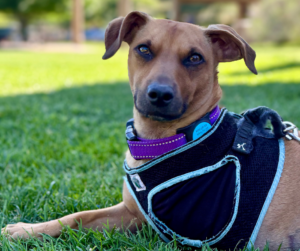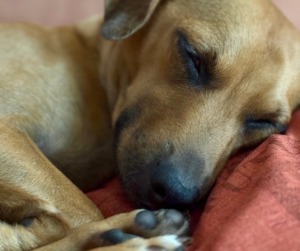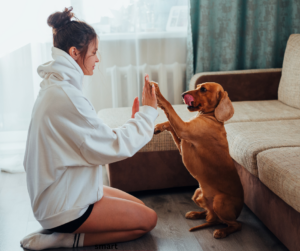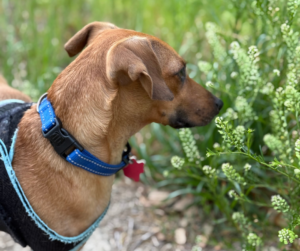Michael Baugh CDBC
Charlie is a perfect dog. That hasn’t changed.
The only thing that’s changed is my perspective. I fell into the trap of thinking Charlie a mythical creature more than a dog. We all do it to some extent. We tell stories to ourselves about our dogs that make them sound like heroes in a Disney film rather than actual thinking, feeling animals.
We make believe they would never growl, never snap, never bite. Sometimes we even ascribe special qualities to them: healing powers, psychic energy, a sixth sense. Magic. We’re human. We make stuff up, even when the truth is already amazing.
What makes the typical dog so exceptional is that he is a typical dog. Dogs are so cool because they want to be with us. Dogs think. They learn. They have emotions. We learn from them. Dogs and humans develop relationships and friendships with each other. Wow! How magical is that?
Dogs also have limits, just like we do. Our dogs get tired, they get sore and achy. Some of our dogs have phobias. Some have survived trauma, physical or mental. Many need our help to navigate the human world (it’s complicated).
If we are being honest, we push our dogs to their limits and put them under pressure. We cast them as mythic dogs, fly them on planes, take them to restaurants, shop and hike and swim with them. We make them our emotional support and forget (sometimes) that they need our support.
I forgot.
 After a long day of climbing red rock trails, Charlie snapped at another dog in the dog park. No one was hurt. Four days later, he went after my nephew’s puppy, Lucky. I expected Charlie to bounce back, to re-engage Lucky. He didn’t. Charlie stayed angry. I’d once called Charlie the most behaviorally sound dog I’d ever met. Now, we had a problem.
After a long day of climbing red rock trails, Charlie snapped at another dog in the dog park. No one was hurt. Four days later, he went after my nephew’s puppy, Lucky. I expected Charlie to bounce back, to re-engage Lucky. He didn’t. Charlie stayed angry. I’d once called Charlie the most behaviorally sound dog I’d ever met. Now, we had a problem.
Lucky is only fourteen-weeks old. She was so cooperative. Charlie, Lucky, and I got to work. We made some progress. Of course, there is more work to do. I have more work to do.
It falls on us humans. This is our responsibility. Charlie was having a hard time. We’d been on a long trip together, flights and days in the car. He’d been to so many places, slept in so many hotels, and now we were at the busy family home in Albuquerque. He was fatigued. I’d pushed him too hard. He was (and is) still a perfect dog. But he wasn’t some Disney character. Perfect dogs need our help. Charlie needs mine.
That’s the way I like to think about it. It’s what I teach my clients. Our dogs aren’t bad. They aren’t defective. Perfect dogs behave in very typical ways, sometimes in ways we don’t like. They need our help. We are presumably the more intelligent species. Who better to help them? We also have the resources to guide them. Again, who better?
Who better, indeed? I do this for a living.
 After twenty-two days of travel, we returned home late on a Wednesday Night. Charlie cuddled in close and fell into a deep sleep. Dogs are amazing, so resilient, so willing to learn and bond. I’ll watch out for you, little buddy. We did a lot on this trip. You did great. I’ll do better. It’s up to me to watch out for your needs, food, water, affection. Rest. I got your back, Charlie. I promise.
After twenty-two days of travel, we returned home late on a Wednesday Night. Charlie cuddled in close and fell into a deep sleep. Dogs are amazing, so resilient, so willing to learn and bond. I’ll watch out for you, little buddy. We did a lot on this trip. You did great. I’ll do better. It’s up to me to watch out for your needs, food, water, affection. Rest. I got your back, Charlie. I promise.
The Mythic Dog. How wrong I’ve been. My dog. Your dog. They are already more than we could ever imagine. How typical. We miss what’s right before our eyes.
I kiss his forehead. Good night, Charlie.
Michael teaches dog training in Arizona and Texas. He specializes in aggressive dog training.


